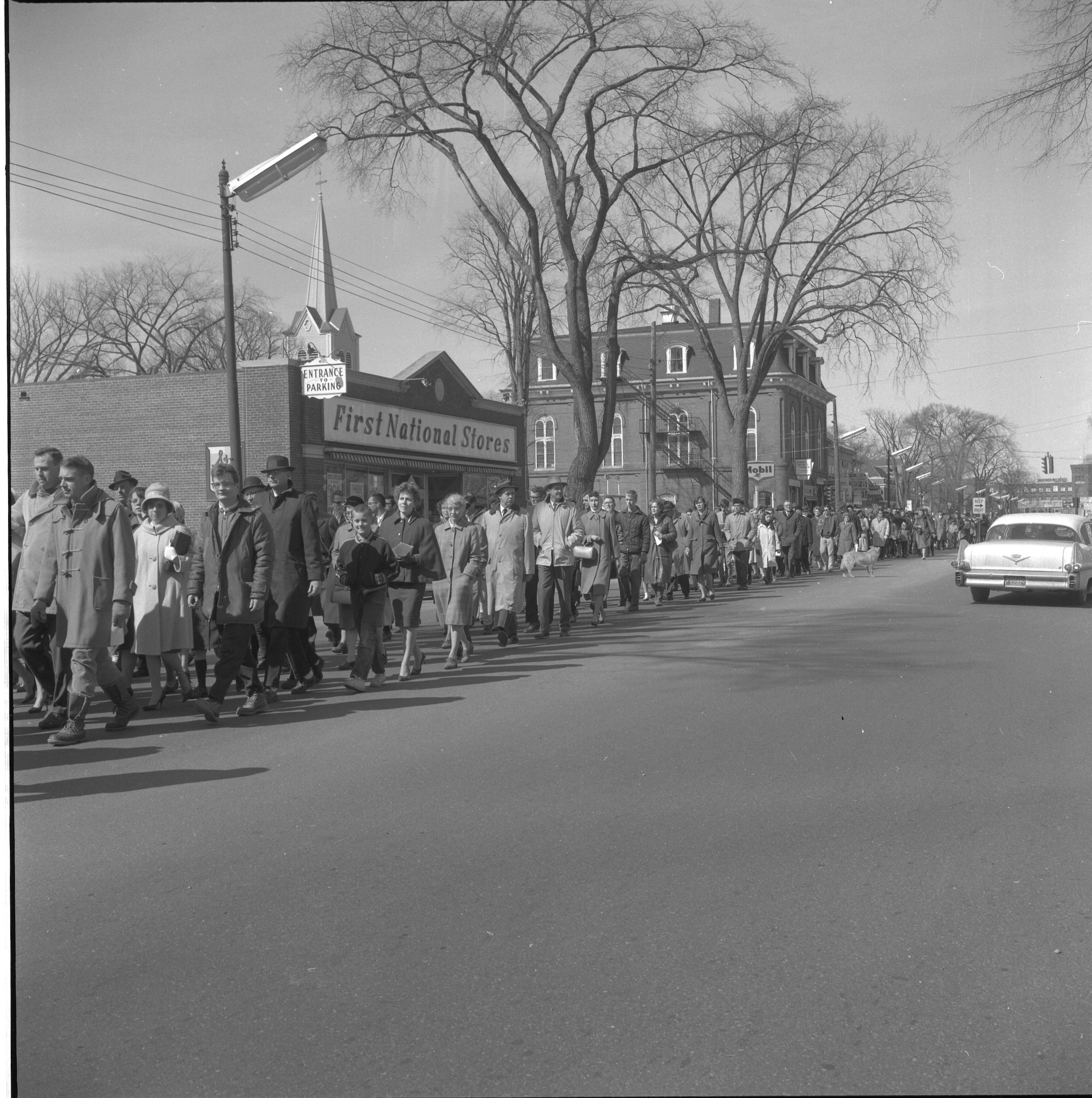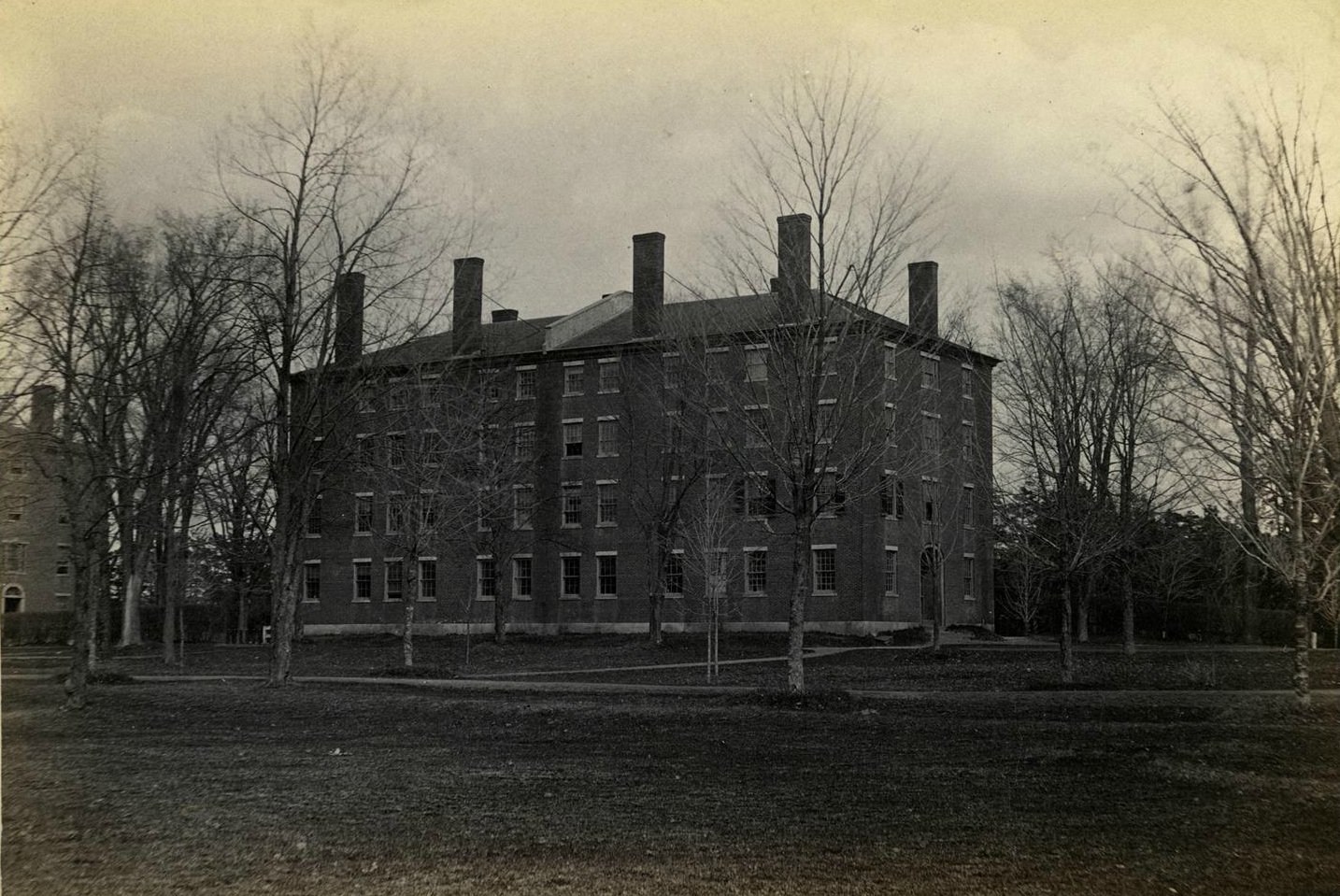This month in Bowdoin history
March 4, 2022
Civil Rights Movement comes to Bowdoin, students participate across nation
 Courtesy of George J. Mitchell Special Collections
Courtesy of George J. Mitchell Special CollectionsFrom March 7 to March 21, 1965, thousands of nonviolent civil rights demonstrators marched from Selma to Montgomery, Ala. Led from Atlanta by Martin Luther King Jr. and from within Ala. by fellow leaders Hosea Williams and John Lewis, activists set out from Selma and Marion, Ala. on March 7. The activists were met on the Edmund Pettus Bridge by a violent wall of state troopers and local law enforcement who attacked the crowd. Television coverage of what would come to be known as “Bloody Sunday” triggered national outrage, and King called upon “religious leaders from all over the nation to join us on Tuesday in our peaceful, nonviolent march for freedom.”
Among hundreds of clergymen who joined the demonstration was longtime civil rights activist and white unitarian minister James Reeb, of Boston. On the evening of the March 11 demonstration, a group of white terrorists attacked Reeb, who died of his injuries two days later. His murder spurred further national concern over the violence in Selma. The outrage extended to Brunswick, ultimately inciting the town’s first civil rights demonstration on Sunday, March 14, 1965.
Students of the College did not remain silent, both in Brunswick and in Selma. Two Bowdoin students, Richard Hoen and Ken Slosberg—who were at the time studying at Morehouse College in Atlanta—demonstrated against police brutality with SNCC in Selma.
The Bowdoin-Morehouse exchange program was only in its second year at the time. Bowdoin students David Bayer ’64 and Phil Hansen ’64 wrote and sent a proposal to Howard Zinn, author of “A People’s History of the United States,” who was teaching at Spelman College at the time. They suggested an exchange between students from the South and the North to increase cultural literacy. Zinn circulated the letter to administrators at both colleges, and the program was approved. The College sent students to Atlanta for a week in March to study at Morehouse and meet with local leaders. The following year, the College hosted Bayard Rustin and Martin Luther King Jr. to speak at the College. The program was discontinued in 1967.
One Bowdoin Orient columnist, Al Purola ’65, discussed Bloody Sunday in his March 12 column, “The Crisis In Selma”—a special installment of his usual column, “Views on the News.” He condemned the abhorrent violence in Selma and throughout the struggle for civil rights. Likening the televised violence to a “Nazi war movie,” he called Bowdoin students and the Brunswick community to action.
“This week’s events may be of monumental importance in the civil rights crisis. If they are, it will not be because the conscience of the nation was aroused, for this can have few tangible results … it will be because the week has been the stimulation for legislation that is a solution … Federal guarantee of voting rights must be forthcoming immediately. There must not be another Selma,” Purola wrote.
On March 14, more than 300 College students, faculty and Brunswick residents showed up to the Brunswick Mill Outlet parking lot to begin a silent march up Maine Street in honor of Reeb. Leading the procession was Reverend Maurice Cobb of the Unitarian-Universalist Church of Brunswick—the same denomination Reeb led in Boston. The march ended at the town mall where Reverend Robert C. Dodds, associate secretary of the National Council of Churches, addressed the crowd of faces from across Brunswick.
“Our doctor was there, my husband’s colleagues were there, my co-workers on the Brunswick Record staff were there, my son’s nursery school teacher was there. We saw ministers, dentists, postmen, sales-clerks. There were men in topcoats and boys in Bowdoin jackets and women wrapped in woolen scarves against the cold, holding their snowsuited children by the hand and walking along. Just walking,” Eleanor Sterling, a columnist for the Brunswick Record, wrote in her column on March 18, 1965.
The march was organized on March 12 by a group of clergymen from the area, the Bowdoin College undergraduate civil rights organization, the Brunswick chapter of the NAACP and the Brunswick Area Turn Toward Peace. Of these groups, only the Brunswick NAACP and local clergymen remain active today.
That same Sunday, another civil rights demonstration was underway in Portland. Cities across the country were marching in unison in remembrance of Reeb and in support of civil rights. The Brunswick contingent, though small, was a powerful symbol of the movement’s reach.
“This was Brunswick, Maine, hundreds of miles from Sylvan Street in Selma, Alabama, hundreds of miles from a bitter city whose Reconstruction Era has never begun, whose Civil War is not yet over,” Sterling wrote.
200 years ago today: Maine Hall set ablaze during the College’s earliest years
 Courtesy of George J. Mitchell Special Collections
Courtesy of George J. Mitchell Special CollectionsHousing students beginning in 1808, Maine Hall was the College’s second building to be constructed but the first to burn down. Exactly 200 years ago, on March 4, 1822, fire erupted in Maine Hall—known then as the “old college”—obliterating its interior.
The College had plans to complete the original Maine Hall in 1796 but, due to depressed land value, it prioritized the more modest Massachusetts Hall as its inaugural structure. Finally, in 1808, the building was complete.
Just as the College planned to break ground on its third structure—a “new college” that would come to be known as Winthrop Hall—Maine Hall went up in flames. Despite financial drain as the College scrambled for funding to reconstruct Maine Hall, Winthrop Hall’s construction began as planned in April 1822, but was not completed until August 1823.
“The fire, which commenced in one of the upper stories, had made much progress before discovered, that it baffled all exertions to save the building,” a clipping from the Gettysburg Compiler of Gettysburg, Pa. documented on March 27, 1822.
George W. Pierce, a member of the Class of 1825 and cousin of U.S. President Franklin Pierce (Class of 1824), was a student living in a private residence at the time of the fire. The Maine Historical Society has transcribed three of his letters detailing the fire, and they have been edited for clarity. Paine wrote a letter to his sisters on March 1, dated before the fire but inferred to have been written after, detailing the event and naming a cause for the fire.
“The fire caught, as is thought, by a coal snapping into a pan of fat which they left on the hearth, the back part of the house was all in a blaze before they discovered it,” Pierce wrote.
However, on March 5 Pierce wrote another letter to his brother naming a second potential cause for the fire. In this later letter, Pierce vowed to “give [him] the correct detail of the burning of the college.” He explained that it could have begun from “fire snapping onto the bed” or something “falling on the floor.”
The fire’s cause remains officially unsolved.
“In spite of the spirited exertions of the Students and townspeople, in less than five hours it was reduced to a heap of ruins,” Pierce wrote in a March 8 letter to his sister.
After the fire, Brunswick residents temporarily housed displaced students in their private residences as plans to rebuild the structure went underway. Among the evacuees was thought to have been Nathaniel Hawthorne, Class of 1825.
“So unfortunate to the Misses Tappans and to several of the students who roomed there, the latter of which lost all their furniture & books,” Pierce wrote in his March 1 letter, which he completed after the fire. “Arria was so frightened that she ran over to Prof. Cleverland’s barefooted.”
The students living in Maine Hall scrambled to save their belongings, leaving the building in a hurry as the flames spread.
“Glasses and chairs were thrown out of the fourth story. When they dropped and hit the ground, they were dashed to pieces. However most of the books were saved except the Theological Library which perished in the flames; but in three or four rooms they lost everything that they had except the clothes that they had on them. Benj Sanbourn lost all his furniture and bed,” Pierce wrote in his March 5 letter.
According to Pierce, the fire began at 3:00 p.m. and did not end until three hours later. The fire brigade arrived quickly after it broke out, but they were unsuccessful in saving the building.
“By this unfortunate event, the students lost most of their books and clothes, and are compelled to quarter upon the inhabitants of the town,” the Gettysburg Compiler reported.
The College placed advertisements in both the local and Portland newspapers searching for proposals to rebuild the dormitory. Administrators finally selected Samuel Melcher III and paid him a sum of $6,409.54 from June to September for the rebuild.
The building was not reconstructed exactly according to blueprints from its initial construction. Rather, the College chose to create rooms dedicated to recitation on the first floor, which would become home to the Peucinian and Athenaean Societies in 1828. The societies used the recitation spaces for libraries and meetings.
Henry Wadsworth Longfellow, a member of the Class of 1825, was a Peucinian Society member enrolled in the College during the fire. Additionally, Athenaean Society members who bore witness to the tragedy included Franklin Pierce and Nathaniel Hawthorne.
Maine Hall fell victim to another fire in 1836, despite upgrades specifically with fire prevention in mind during the first rebuild. During the second rebuild, extra rooms were added to the first floor to accommodate the two recitation societies’ companions in science, Phi Alpha and Caluvian.
Additionally, the building’s exterior was modified slightly, deviating from its original design to which Winthrop Hall’s construction attempted to remain faithful. Among other features, Maine Hall stands taller than Winthrop Hall, and its entrances are more deeply recessed into the building—a testament to the later architecture style. The exterior has not been changed since 1837. Today, Maine Hall remains as one of the College’s eight first year residences, its history burned away by 200 years.

Comments
Before submitting a comment, please review our comment policy. Some key points from the policy: